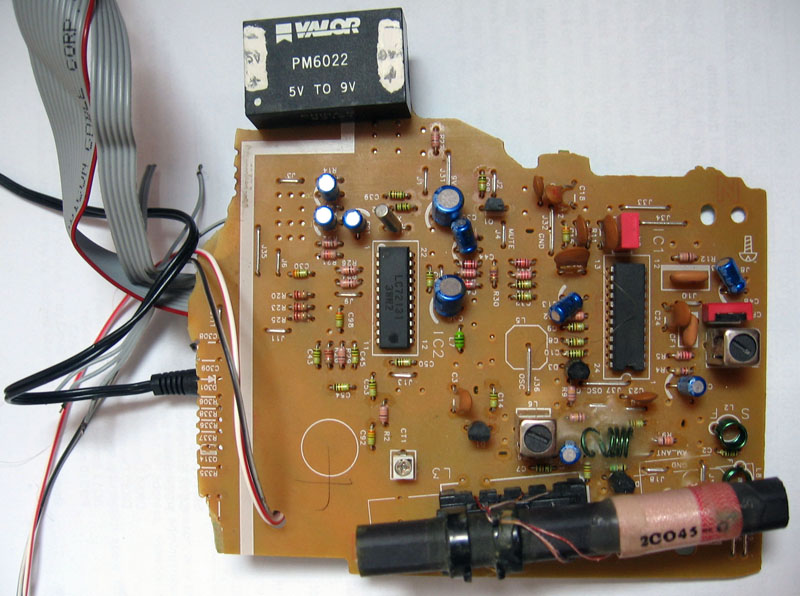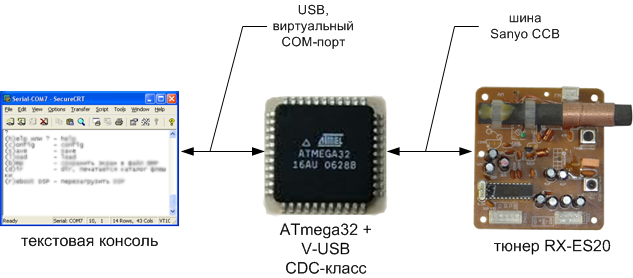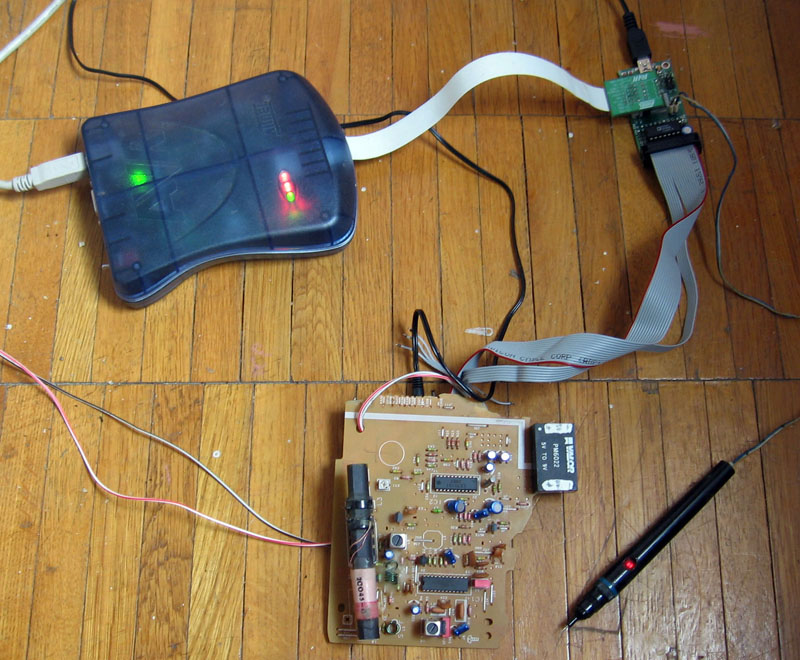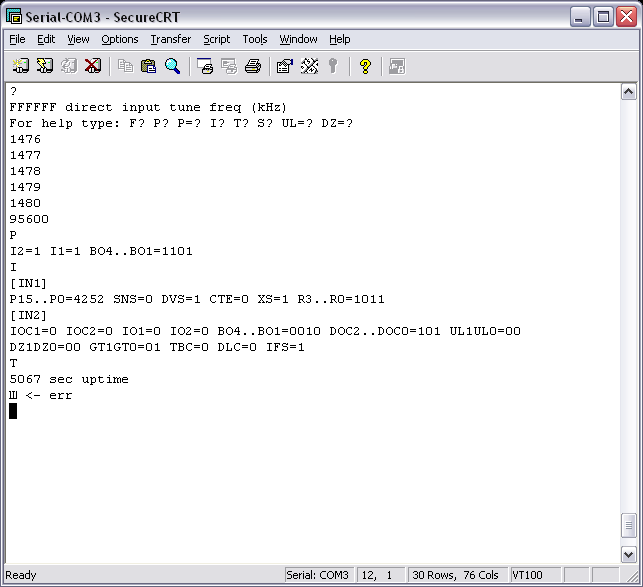As I revived the radio receiver RX-ES20
My nature is arranged in a very strange way - I can not easily walk past the discarded old radio iron. Sorry for her, that lies discarded and no one needs, I want to drag home, repair or disassemble for parts. Therefore, my whole house is crammed with various radio-rubbish, which does not raise a hand. Probably, such instincts have been instilled in me since childhood, when it was almost impossible to get radio components into the bad old days of socialism. The range was small in the store, there was something on the market, but there was never enough money, so you had to make raids on all sorts of landfills in search of radio components.
Recently, at work I caught the eyes of the intestine from the radio RX-ES20 . Someone dismantled the hull in a barbaric way, broke down electronics with meat and threw it away. I managed to save a piece from the board, on which was the radio path of the radio, assembled on chips TA2008 and LC72131 .

')
I immediately found out from the Internet that the TA2008 is an AM / FM tuner (a radio frequency amplifier, a local oscillator, a mixer, an intermediate frequency amplifier), and the LC72131 is a frequency synthesizer for a local oscillator controlled from a microcontroller. That is, the frequency to which the radio is tuned is determined by the data that the microcontroller writes to the Sympaty synth. I have long dreamed of building a receiver with a digital frequency setting, so I became interested and continued searching for information. I found the service manual for the RX-ES20, where the circuit diagram was, downloaded the datasheets for TA2008 and LC72131, and began to figure out how it all works.
The radio path of the radio RX-ES20 is the simplest - it can only work on CB ( AM MW 522..1629 kHz , 9 kHz tuning step) and on VHF ( FM 87.5..108 MHz , tuning step 50 kHz). The LC72131 synthesizer turned out to be very advanced, and in order to understand its working principle, I had to translate the datasheet completely.
To control the radio path from the microcontroller, it is required to exchange data with the LC72131 via a 4-wire interface with PLLDO, PLLDA, PLLCLK, PLLCE ( CCB Sanyo bus) signals, and also to set the T_MUTE signal (if it is in log. 1, the radio path is disabled). The search for ready-made subroutines for controlling the LC72131 brought me to an interesting radio amateur receiver R-45 project (see References below), from which I borrowed subroutines for recording a synthesizer (the ATmega8 microcontroller was used in the R-45, and I have ATmega32 , but these were trifles) . There were no subroutines for reading the synthesizer (the DO synthesizer leg was not used), I added.
The radio path was decided to be connected to the AVR-USB-MEGA16 mock-up board, on which the ATmega32 microcontroller was installed. It provided the ability to control the receiver via USB - simple text input of commands and text output to the console via a virtual USB COM port (using the V-USB library and CDC USB class), so it was not necessary to write a program for the computer. Based on the source code of the CDC-232 Osamu Tamura project (the project is based on V-USB , see References).

From the other junk, the VALOR DC-DC converter came in handy (to get 9 out of 5 volts), the cable from the old ATA hard drive, the cord from the headphones, and the jack (jack) from the audio card. Cable and socket soldered canopy on the board tracks. The project is in the process of debugging:

The radio path is controlled by the following commands:
FFFFFF Direct input of the receiving frequency in kHz (here the symbols F mean frequency digits)
Up arrow Increase in receive frequency per tuning step (in AM mode, I made 1 kHz, in FM mode, 25 kHz)
down arrow decrease reception frequency per tuning step
F to measure and show the tuning frequency of the local oscillator, the frequency of reception of the radio path
P = bbbb set the state of the output ports BO4..BO1 of the synthesizer chip LC72131 (the symbol b means 0 or 1, the state of the corresponding output BOx).
P read and show the status of the ports IO2, IO1 (inputs), BO4..BO1 (outputs) of the synthesizer chip LC72131
I show detailed information. Displays the contents of all internal flags of the LC72131 synthesizer chip, the frequency division ratio of the synthesizer.
? command prompt
When stereo reception (FM band) is received, a red LED lights up on the breadboard. The synthesizer can be rebuilt in the range of 0.5 ... 160 MHz, but in reality the reception goes only to the MW and VHF (as the radio path to the other bands is not calculated).
Screenshot of the radio control console:

If someone is interested in boring technical details, welcome to Links.
[ Links ]
1 . Translation datashita LC72131 .
2 A detailed description of the project, firmware control of the radio path of the receiver on the ATmega32 . According to the link you can download the source (project for AVR Studio), a schematic diagram of the radio RX-ES20, photos.
3 R-45 - radio amateur scanning receiver 45..855 MHz.
4 AVR-CDC Osamu Tamura @ Recursion Co.
Recently, at work I caught the eyes of the intestine from the radio RX-ES20 . Someone dismantled the hull in a barbaric way, broke down electronics with meat and threw it away. I managed to save a piece from the board, on which was the radio path of the radio, assembled on chips TA2008 and LC72131 .

')
I immediately found out from the Internet that the TA2008 is an AM / FM tuner (a radio frequency amplifier, a local oscillator, a mixer, an intermediate frequency amplifier), and the LC72131 is a frequency synthesizer for a local oscillator controlled from a microcontroller. That is, the frequency to which the radio is tuned is determined by the data that the microcontroller writes to the Sympaty synth. I have long dreamed of building a receiver with a digital frequency setting, so I became interested and continued searching for information. I found the service manual for the RX-ES20, where the circuit diagram was, downloaded the datasheets for TA2008 and LC72131, and began to figure out how it all works.
The radio path of the radio RX-ES20 is the simplest - it can only work on CB ( AM MW 522..1629 kHz , 9 kHz tuning step) and on VHF ( FM 87.5..108 MHz , tuning step 50 kHz). The LC72131 synthesizer turned out to be very advanced, and in order to understand its working principle, I had to translate the datasheet completely.
To control the radio path from the microcontroller, it is required to exchange data with the LC72131 via a 4-wire interface with PLLDO, PLLDA, PLLCLK, PLLCE ( CCB Sanyo bus) signals, and also to set the T_MUTE signal (if it is in log. 1, the radio path is disabled). The search for ready-made subroutines for controlling the LC72131 brought me to an interesting radio amateur receiver R-45 project (see References below), from which I borrowed subroutines for recording a synthesizer (the ATmega8 microcontroller was used in the R-45, and I have ATmega32 , but these were trifles) . There were no subroutines for reading the synthesizer (the DO synthesizer leg was not used), I added.
The radio path was decided to be connected to the AVR-USB-MEGA16 mock-up board, on which the ATmega32 microcontroller was installed. It provided the ability to control the receiver via USB - simple text input of commands and text output to the console via a virtual USB COM port (using the V-USB library and CDC USB class), so it was not necessary to write a program for the computer. Based on the source code of the CDC-232 Osamu Tamura project (the project is based on V-USB , see References).

From the other junk, the VALOR DC-DC converter came in handy (to get 9 out of 5 volts), the cable from the old ATA hard drive, the cord from the headphones, and the jack (jack) from the audio card. Cable and socket soldered canopy on the board tracks. The project is in the process of debugging:

The radio path is controlled by the following commands:
FFFFFF Direct input of the receiving frequency in kHz (here the symbols F mean frequency digits)
Up arrow Increase in receive frequency per tuning step (in AM mode, I made 1 kHz, in FM mode, 25 kHz)
down arrow decrease reception frequency per tuning step
F to measure and show the tuning frequency of the local oscillator, the frequency of reception of the radio path
P = bbbb set the state of the output ports BO4..BO1 of the synthesizer chip LC72131 (the symbol b means 0 or 1, the state of the corresponding output BOx).
P read and show the status of the ports IO2, IO1 (inputs), BO4..BO1 (outputs) of the synthesizer chip LC72131
I show detailed information. Displays the contents of all internal flags of the LC72131 synthesizer chip, the frequency division ratio of the synthesizer.
? command prompt
When stereo reception (FM band) is received, a red LED lights up on the breadboard. The synthesizer can be rebuilt in the range of 0.5 ... 160 MHz, but in reality the reception goes only to the MW and VHF (as the radio path to the other bands is not calculated).
Screenshot of the radio control console:

If someone is interested in boring technical details, welcome to Links.
[ Links ]
1 . Translation datashita LC72131 .
2 A detailed description of the project, firmware control of the radio path of the receiver on the ATmega32 . According to the link you can download the source (project for AVR Studio), a schematic diagram of the radio RX-ES20, photos.
3 R-45 - radio amateur scanning receiver 45..855 MHz.
4 AVR-CDC Osamu Tamura @ Recursion Co.
Source: https://habr.com/ru/post/95318/
All Articles